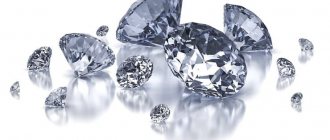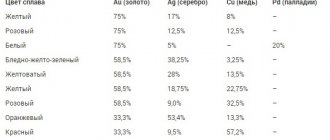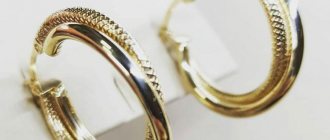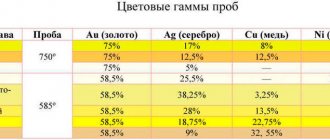I greet honorable guests who are interested in jewelry. In this article I will cover the topic of assessing the quality of noble metals and tell you what systems exist for this and how they are characterized. You will also learn the difference between a fake and a real piece of jewelry and what purpose gold samples have in general. But first, let's briefly explore the general concepts.
What is a sample?
It is immediately worth noting that the sample can be any metal consisting of two or more components. It shows the content of the alloying element in relation to the main part. This term is often used in the jewelry industry, where it is necessary to extremely accurately determine the proportion of expensive material in precious alloys.
In a gold ring, the fineness determines the volume of the gold itself. Most jewelry does not consist of pure expensive metal, but is a mixture with others that are cheaper and have certain properties. This way the finished decoration is given the necessary hardness, plasticity, color, etc.
What impurities are added to gold?
Let's look at the example of gold. It can be fused with almost any component, achieving the desired characteristics of the future product. The following materials are considered the main ones:
- Nickel increases fluidity during melting.
- Copper increases hardness while maintaining elasticity.
- Silver in different proportions can give a different color.
- Platinum gives whiteness and elasticity.
- Palladium and zinc change their melting point.
As you can see, gold is alloyed with many metals to give it the right properties. So, in any jewelry store you can see products made of white, yellow, red, rose gold, etc.
Gold samples
The term "fineness" indicates the amount of precious metal in an alloy. But how can we understand this? For example, a ring purchased in Russia has a three-digit number stamped on it, while a ring from the USA or Europe has a two-digit number. All these markings have the same meaning, they just present it differently. This is due to different systems by which samples are determined and different units of measurement.
Spool system
The main unit of measurement here is the spool. By weight, it is equal to 1/96 of a pound, which is approximately 4.266 g. This is how the golden share was measured in ancient times (1711–1927), so products with two digits on the surface are considered a rarity.
There were 7 samples in total - 36, 56, 72, 82, 92, 94 and 96. If you have 36 spools and multiply this figure by 2.44 (so many pounds equal 1 kg), and then by 4.266, you get the familiar three-digit 385 sample .
Metric system
This classification was introduced by the Soviet Union immediately after the spool one. It is much more practical and shows the quantitative gold content in the precious material in grams familiar to us. That is, in 1 kg of alloy of the same 385 purity of pure gold there will be only 385 grams, and the rest (615 g) comes from other components - nickel, copper, silver, etc.
Lot system
This specification was used for a very long time in Western Europe, where the mass of precious metals was measured in marks. It is similar to the spool valve, it is also considered old-fashioned and is no longer used today. I will not say how much one stamp weighs, but will simply clarify how it compares to a three-digit sample.
To convert a lot value to metric, it must be multiplied by 125 times and then divided by 2. There are samples of 6, 8, 12, 14 and 16 lots. For a product with mark 6, after manipulation it turns out that it corresponds to 375 standard. Therefore, the 6 lot alloy contains 375 grams of pure gold.
Carat system
This classification prevails in the USA and in some European countries. A carat is the official unit of measurement for precious stones; it is equal to 0.2 g. A drop of gold weighing 1 g is denoted 5 k according to the American system. However, this is not how the sample is determined.
The essence of marking a precious product is that the material from which it is made is divided into 24 parts. That is, the usual one kilogram is replaced by 24 carats, and the value of pure gold is applied to the product. For example, a sample of 18 k means that for 24 parts of the entire alloy there are eighteen parts of pure gold (75%). If this number is multiplied by 1000 and divided by 24, the result is 750 fineness, which means the content of 750 grams of gold in the alloy.
Correspondence table between different systems
| Sample ratio of different measurement systems | ||||
| Metric | Zolotnikovaya | Lotovaya | Carat | Gold in % |
| 990–999 | 96 | 16 | 24 k | 99% and above |
| 958 | 92 | 15,3 | 23 k | 95,80% |
| 916–917 | 88 | 14,6 | 22 k | 91,67% |
| 875 | 84 | 14 | 21 k | 87,50% |
| 833 | 81 | 13,3 | 20k | 83,33% |
| 800 | 76.8 | 12,8 | 19.2k | 80,00% |
| 792 | 76 | 12,7 | 19 k | 79,17% |
| 750 | 72 | 12 | 18 k | 75,00% |
| 625 | 60 | 10 | 15k | 62,50% |
| 583–585 | 56 | 9,3 | 14 k | 58,33–58,50% |
| 500 | 48 | 8 | 12 k | 50% |
| 417 | 40 | 6,7 | 10k | 41,67% |
| 375 | 36 | 6 | 9 k | 37,50% |
| 333 | 32 | 5,3 | 8k | 33,33% |
Which sample is better?
If you rely on cost, then the highest will be 999 samples. It is placed on gold products that do not contain alloying elements. However, from a practical point of view, it may not be the best since pure gold jewelry is so soft that it can be bent by hand. That is, a ligature in the alloy is necessary in any case.
Expert opinion
Vsevolod Kozlovsky
6 years in jewelry making. Knows everything about samples and can identify a fake in 12 seconds
750 is considered the most successful of all samples, since the nickel, silver, copper and platinum it contains provide optimal properties when making jewelry. It is especially valued by craftsmen who melt and create their own masterpieces. The only problem is the price, which is why jewelry with such a hallmark is rarely produced.
The most popular is 585, from which about 90% of all gold rings, earrings and other jewelry assortment are produced.
Silver
In Russia, the following silver standards are legally permitted for use: 800, 830, 875, 925, 960, 999.
875 standard silver is the most practical and widespread. It is from this alloy that most silver jewelry is made. The alloy contains 81.5% pure silver. The rest is made up of copper, which effectively prevents the oxidation of the metal. 875 sterling silver is less susceptible to tarnishing than 830 and 720 sterling silver.
Tableware items are made from 916 sterling silver. The 960-grade alloy is used in the manufacture of particularly filigree products.
To protect silver and brass items from oxidation, their surface is often coated with a thin layer of .999 gold (gilding) or .999 silver (silver plating).
Color and sample ratio table
The color of gold, as well as its mechanical properties, directly depend on the impurities it contains. For example, silver will make the alloy green, while palladium and platinum are considered brighteners. At the same time, one brand of gold can have several colors and shades at once, so the table below does not show all the sample numbers, but only the main ones from which jewelry is made.
| Try | Alloy components (grams per 1 kilogram) | Color | ||||
| Gold | Silver | Palladium | Nickel | Copper | ||
| 333º | 333 | 334 | — | — | 334 | Orange |
| 534 | — | — | 133 | Yellow-green | ||
| 445 | — | — | 222 | Yellow | ||
| 200 | — | — | 467 | Pink | ||
| 95 | — | — | 572 | Red | ||
| 375º | 375 | 100 | 38 | — | 487 | Pale yellow |
| 583º | 583 | 80 | — | — | 337 | Yellow |
| 300 | — | — | 117 | Green | ||
| — | — | — | 417 | Red | ||
| 585º | 585 | 80 | — | — | 335 | Red |
| 90 | — | — | 325 | Pink | ||
| 187, 5 | — | — | 227, 5 | Yellow | ||
| 300 | — | — | 115 | Green | ||
| 100 | — | — | 30 | White | ||
| 750º | 750 | 170 | — | — | 80 | Yellow |
| 125 | — | — | 125 | Pink | ||
| 50 | — | 200 | — | White | ||
What brands of gold are there in Russia?
The metric system is used in the Russian Federation and other CIS countries. The hallmark shows the pure gold content of the alloy. Not all brands are suitable for making jewelry that can be bought in jewelry stores. Thus, 7 samples are officially released in Russia:
- 375;
- 500;
- 585;
- 750;
- 900;
- 916;
- 958.
All gold products are made from them. 585 is considered the most common, the rest are used much less frequently.
White gold
White gold, in fact, does not exist. This is ordinary gold with different metal contents in the alloy.
- 585-carat white gold: 23.7-28.7% - silver, 13.0-18% - palladium, 17% - nickel, 8.7% - zinc, 16% - copper.
- 18k white gold: 7.0-15.0% silver, 14% palladium, 4% nickel, 2.4% zinc, 7.5-16.5% nickel, 15% copper .
White gold is in high demand among jewelry lovers and is an excellent companion for diamonds.
Popular brands in the world and in Russia
The most prestigious and widely used in the world is the 750 stamp. This can be explained by the favorable ratio of gold and alloying elements in the alloy, which has the most favorable properties - melting point, strength, elasticity, hardness, etc. Jewelry made from it never darkens or wears out, but has a high cost.
In Russia, preference is given to 585 sample, since its characteristics are almost as good as 750, and the price is much lower. Products made from such an alloy are found in every jewelry store in the Russian Federation and are considered mass-produced.
Price per 1 gram
Below you can see the cost per gram of gold. The data is provided by the Central Bank of the Russian Federation in accordance with the daily updated exchange rate.
| Price 999 standard according to the Central Bank | Market value of the sample today | Scrap price | Price in jewelry |
Important Details
There are three ways to apply impressions:
- impact - applied mechanically to the stamp matrix;
- electric spark - applied with special equipment, the contour is not completed;
- laser - applying an imprint using laser engraving.
In Russia, the metric system of gold and silver samples has been adopted. The fineness of the alloy determines its value - the more precious metal, the more expensive. The remaining components (copper, zinc, nickel) are used to give the alloy strength and wear resistance, as well as some color. The color of the alloy does not depend on the standard: for example, 585 gold can be red, yellow, white and other colors, depending on the combination of alloys used.
The law does not require the marking of jewelry weighing up to three grams. Therefore, if you suspect that you have been sold a counterfeit item due to the lack of a stamp, first weigh the jewelry.
What standard is gold in jewelry?
The cheapest and lowest stamp on Russian jewelry is 375. According to standards, it should be placed on a product that contains at least 30% gold. Accordingly, the rest (70%) falls on other metals.
The most valuable is the 958 sample, which is very rare due to its high cost. In addition, products made from it are short-lived, they are soft, and are easy to damage. Therefore, jewelers prefer to use the reliable 585 grade, which has satisfactory appearance and mechanical characteristics.
Below is a video about gold samples:
How to see the sample on jewelry?
To see the treasured three numbers, you need to try hard, because they are placed in those places that are hidden to the maximum from the human eye. For example, on rings this is the back side adjacent to the finger, on earrings and chains it is a lock. The font is so small that a clear picture can only be obtained by magnifying it, so arm yourself with a magnifying glass.
Marking and hallmarking of gold jewelry
A product is considered genuine if it has passed the assay inspection. This is a special inspection that studies the composition of the alloy and, if it corresponds to the brand declared by the manufacturer, puts a stamp on it. It should have 3 elements:
- The inspection symbol is a woman's head.
- The inspection code is most often a letter.
- Sample - 3 digits.
This is how products are branded in the Russian Federation. In addition to the main one, they also put an additional brand consisting of 4 letters:
- 1 letter - code of the year of manufacture.
- 2nd letter - inspection code (letter).
- The 3rd and 4th letters are the personal mark of the manufacturer.
Thus, if a piece of jewelry contains 2 such marks, then it is real and has passed state control.
What symbols are on bars and coins?
Ingots made of precious metal are marked differently. The main symbols are weight in grams, gold content, and pig number. It is worth noting that such blanks are designed to store only 999.99 samples, so it is placed in special boxes and packaging, protecting it from damage.
The coins are already made from an alloy with the mark 900–990. Here the value of gold is neglected, since the main value lies in significance - an antique or a rare award.
Disadvantages of Cheap Jewelry
Low-cost jewelry is made mainly from 375–500 marks. Such gold is called low-grade and is not in demand among jewelers. Its main drawback is the foreign color, because an alloy containing more than 50% alloy cannot have a rich yellow tint. It is often reddish due to copper or greenish due to silver, and also quickly loses its luster. For this reason, it is impractical to create things from it that require a lot of time and labor.
What are there
The quality of the alloy is indicated on each piece of jewelry. Knowing the decoding of the digital value, you can easily determine the amount of aurum and impurities of other metals. So, let's look at what gold samples are in Russia:
375
This figure tells the owner that the jewelry consists of 37.5 percent gold, the remaining 63 percent is an admixture of silver and copper. The reddish tint of the jewelry indicates the predominance of copper, the yellowish tint indicates the predominance of silver. The advantages of jewelry with this mark are durability, low price, and preservation of the original shape. But unfortunately for the owners, the alloy is easily oxidized, and the surface is coated with iron sulfide.
500
The rarest gold sample existing on the territory of modern Russia. Composition – fifty (aurum) to fifty (copper, silver). By increasing the proportion of pure precious metal, manufacturers managed to get rid of oxidation, but the appearance remained at the same level.
583
Products with such numbers are no longer produced. This designation is labeled 585.
585
A common and well-known marking with 585 purity. Jewelers consider this ratio to be the most acceptable for the production of jewelry. Alloys of this ratio are used for the manufacture of precious trinkets abroad. An externally beautiful product, an affordable price and excellent characteristics have made this marking popular.
750
The highest standard used in jewelry. 75 percent - noble metal in its pure form with the addition of a small amount of silver, copper, palladium. The shade of a gold product and its purity directly depend on each other. The predominance of additional metal affects the color of the trinket. It comes in red, yellow, dark green or even dark blue and black. This alloy is durable and easy to process.
958
An alloy of this composition is not suitable for the production of jewelry. The high content of pure gold (more than 95%) makes the product soft and easy to bend. Suitable for making coins or other custom collectibles. The cost per gram will be high.
980
980 gold standard is not suitable for jewelry. During the time of Peter I, starting in 1711, it was used for minting coins and was considered a valuable coin precious metal. Another name - royal gold or ducat - is familiar to many collectors. If such coins are well preserved, their price will be very high.
999 (“three nines”)
Pure gold, unsuitable for rings, earrings, chains and other trinkets. It can be found in the form of bars stored in banks, which gives owners confidence in the future. In the markets, the price of bullion, gold plating, etc. depends on many indicators.
The types of gold samples considered are used for their intended purpose, according to the characteristics they have. There are also hallmarks such as 900 and 525, which are very rare.
Which authorities regulate the marking of gold samples?
In 1999, the act “On the hallmarking of products made from precious metals” was issued, which regulates the testing of alloys for gold content and their certification at the legislative level. This work is performed by the Ministry of Finance of Russia, or more precisely, its division - the Assay Inspectorate. If the properties of the product declared by the manufacturer are confirmed, then it puts its own mark (see above), and also, if necessary, issues a certificate of quality.
Why do you need to standardize the composition?
Standardization is necessary to document the quality declared by the manufacturer. The stability of the house or tower during construction will depend on this. That is, a standard is something to be compared to in production.
In the jewelry industry, the price category is also added to this value. Thus, gold jewelry made from different gold samples have different prices and differ in mechanical properties.











